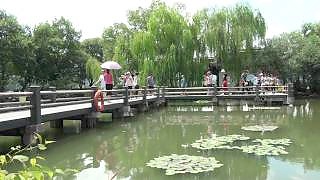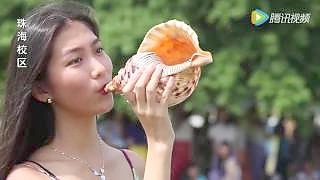 Something different – the wisdom of Mark Twain
Something different – the wisdom of Mark Twain
Related Videos
Featured Videos

|
With ClaireTrips ...
|

|
With Valeriy Blank ...
|

|
HangZhou lies 180 kilometers south west of ShangHai in the YangTse River Delta and is the capital of ZheJiang province.
With abundant natural scenery, including the famous West Lake, HangZhou has been a popular city for over 2,000 years when it was founded during the Qin dynasty. It is listed as one of the seven great ancient capitals of China. The West Lake covers 6 square km and is surrounded by historical sites and scenic areas.
HangZhou lies at the southern end of the Grand Canal of China, with a length of nearly 1,800 km; at the northern end lies BeiJing. It was completed around 600 AD during the Sui dynasty. The longest man-made canal in the world, by far, it is a fine example of China's achievements, which include invention of the canal lock (Song dynasty; 10th century).
HangZhou is also noted for tea, silk, umbrellas and fans.
|

|
December 2013. From the tropical far south of China to the frozen far north, a temperature difference of around 50C in winter!
The Harbin International Snow and Ice Festival starts in early January. In 2014, the festival celebrated its 50th birthday and was bigger than ever. See the snow sculptures by day and the ice lantern structures by night. A winter wonderland :)
Runs to the end of February (approximately, weather dependent).
|

|
2016 年中山大学毕业季快闪
Sun Yat-Sen University, also known as ZhongShan University, is a public university in GuangDong, south east China. It was founded in 1924 by Dr. Sun Yat-Sen, a revolutionary and the founding father of the Republic of China.
Don't miss this; the song at 6:00 will melt any frozen heart ...
Malaysian student's 1 month cultural exchange stay.
We all get older, but never lose your childhood wonder and love for life ...
Life at SYSU ...
|

|
它出淤泥而不染,濯清漣而不妖,一池荷花,一桌菜 | 野小妹
|

|
A 70 minute feature length film.
Starting at MuTianYu Great Wall, Beijing.
|
Tag search ?






 Something different – the wisdom of Mark Twain
Something different – the wisdom of Mark Twain
![With Roger Waters. Exceptional talent here. Love music; love peace ? Then you`ll love this. Know every note, or first time listen - let`s go . . . . . Ashes and diamonds; We are all equal, In the end. Mother, will they drop the bomb ? [hint - they did already - two different designs tested on the [`inferior`] women, children and elderly of Hiroshima and Nagasaki; among others]. Mother, should I trust the government - [no ****ing way ! Five Eyes brat pack] Mother / state / control. Only because the masses are (deliberately) distracted by TV, shopping, sex, fashion, alcohol, gambling, and more, can the tiny minority elite enslave us. It`s like a cult; part of it ? Alive, or just a robotic believer ?? A fool is one who doesn`t know what they are doing, or why they are doing it. Don`t be fooled. Bonus film 1 : Bonus film 2 - Us and Them : Or is it really just `WE` ?! Don`t believe anyone. Don`t believe any ism. Don`t even believe in truth. Truth is reality; no belief required. It`s all there to all who can see clearly, without blinkers. Something different - 100 seconds to midnight (the very end; music)](https://img.youtube.com/vi/4vu24954p4k/mqdefault.jpg)






